Research Article
AN ASSESSMENT OF FACTORS ON EFFECTIVE EMPOWERMENT & CHANGE IN CONSUMER DYNAMICS ON PRODUCTS AT BOP: AN ANALYTICAL STUDY OF RURAL ODISHA
3926
Views & Citations2926
Likes & Shares
In the present scenario, more particularly the rural customer has focused on selecting an appropriate retail product, value addition, cost effective, income generating retail malls in the process of BoP, which provides value added services. Their expectations are also focuses on their needs and is responsive to their concerns and issues. Customers prefer a particular retail outlet if they find value over their total shopping cost. Her an analytical case of Odisha rural purchase behavior of both the groups(gender) have been analyses for measuring any deviations in perception level and consumer dynamics also have been analyzed through factor analysis. Out of the total eighteen factors only seven major factors have more influence on the change of consumer dynamics in the product process and there was no issue on empowerment.
Keywords: Retail, BoP, Dynamics, Empowerment, product-chain
Consumer dynamics in India is fast changing with the change environment and style. So, the retailers need to take proper attention towards this and to formulate their strategies to deliver the best value addition to their consumers. As we know, India is the second largest consumer retail market in the world. So, each individual type of retailer needs to evaluate the consumer dynamics in the retail market more meticulously. This primarily involves identifying the key drivers of growth, the consumer’s demographics and their expectations. It also means to evaluate the nature of competition and challenges in the rural market place. All these have led the Indian organized retail sector to give more attention to an analysis of the consumer buying behavior in order to satisfy the target market’s needs more effectively than its competitors.
The customers process the information around them and approach the retail space to consume according to their expectancy level. Consumers approach different store types to explore product views and to shop products according to their needs and their desired outcomes. Some customers prefer to move frequently the brand stores to update themselves with the brand basket change over the time where as others prefer to visit retail shops with competing brands to enjoy high price offers.
Consumers buying or prefering a particular retail outlet is the behavioral issue which influences their reference groups (friends, relatives and so on), culture, their upbringing, family life cycle, income and attitude etc. The store image is a determinant which helps customer to patronize a particular retail store. The shopping experience factors bridge a relationship with the prospects for regular shopping experience.
In the present scenario, time is constraint and money has become luxury. So, more particularly the rural customer has focused on selecting an appropriate retail outlet, which provides value added services, focuses on customer’s needs and is responsive to customer concerns and issues. Customers prefer a particular retail outlet if they find greater return over their total shopping cost.
In the year 2002, C.K. Prahalad and Stuart Hart published a groundbreaking article in Strategy+Business magazine that introduced to the world the idea of the Bottom of the Pyramid (BOP). The idea, which says that the poor present a vast untapped business opportunity, and if companies serve the poor, they can help eradicate poverty and also make a profit, revolutionized business thinking. Funnily though, before 2002, the idea had no takers: various management journals.
In recent years, ‘market-based’ approaches to development have gained considerable ground in development circles, bringing significant private-sector resources to bear on global concerns of poverty, disease, hunger, and women’s empowerment. Within this context, the bottom-of-the-pyramid (BoP) approach championed by the C.K. Prahalad has been heralded by some as a remarkable change in approaches to economic development of the country (Prahalad 2004).
The idea behind BOP suggests that the best way to meet the needs of the rural poor is through a profit driven market-based approach. As a result, there are significant benefits for the rural poor in terms of poverty reduction, increased productivity, and empowerment. Companies interested in exploring the opportunities at the BOP look for solutions in the form of new products with new business models. Basically, this approach provides products and services at affordable prices in remote areas. The Bottom of the Pyramid (BoP) constitutes the market made up by the poorest people of the region.
The basic BOP argument can be summarized succinctly as follows:
- There is much untapped purchasing power at the bottom of the pyramid. Private companies can make significant profits by selling to the poor.
- By selling to the poor, private companies can bring prosperity to the poor, and thus can help eradicate poverty.
- Large multinational companies (MNCs) should play the leading role in this process of selling to the poor.
The BoP approaches not only open new markets and business opportunities for the private sector, but also offer channels for commercial revitalization and ethical commitment, which are key pillars for urban sustainability.
Scope of BOP
Rural poor, at the bottom of the pyramid (BoP), represent a very attractive market opportunity. The ‘BoP proposition’ argues that selling to the rural poor can simultaneously be profitable and help eradicate poverty. This is at best a harmless illusion and potentially a dangerous delusion. The success stories of MNCs serving poor customers cited in the BoP literature are predominantly in fast-growing economies such as India, where the GDP per capita remains low.
The Bottom of the Pyramid approaches offers the private sector an opportunity to lead the way towards urban economic and social transformation in the 21stcentury. What is fundamentally required is the elicitation of the adventurous spirit of the sector to push the frontiers of market economics to new heights. The risk-taking attitude of the entrepreneurs of the industrials revolution who opened the wells of wealth to humanity through inventions and innovations needs to be relived in our times.
KEY CHALLENGES OF BOP
A marketer trying to market his product or service in the rural areas is faced by many challenges; the first is posed by the geographic spread and low population density in the villages in the country. The second challenge is from the low purchasing power and limited disposable incomes in these parts of the country.
Buying Behavior is the decision processes and acts of people involved in buying and using products. It is necessary to understand the followings before decision towards the market:
- Why consumers make the purchases that they make?
- What factors influence consumer purchases?
- The changing factors in our society.
The changing demographic profile of the population in terms of education, income, size of the family and so on, are important in the context of what will be more substantive in the days to come will be the psychographics of customers, how they feel, think or behave.
Consumer buying behavior is dynamic. Therefore, it is necessary to continuously study, analyses and understand it and monitor this understanding to the marketing management so that effective decisions can be taken in respect of products, price, promotion and distribution. The profit position of a product hinges on the kind of pre- disposition - positive/negative - on which a consumer has developed towards BoP market.
The changing concept of retail business into 'retail in detail', emergence of giant-sized retail business in the name of malls and the government's policy to allow foreign direct investment in retail business also change the life style and the buying patterns and preferences of the consumers in India, more particularly in BoP market. In this context the consumer is confronted with a complex set of alternatives in many purchase situations.
OBJECTIVES OF THE STUDY:
The present study has planned the following objective:
- To analyze the consumers’ attitude and buying behavior on the products and to measure the difference across gender on empowerment.
Dixit &Sharma (2012), findings was on Rural markets, which require patience and investment by companies as in some case the companies have to build the entire product category and not only position their brands. Thus, marketers are not only marketing products but they are contributing in nation building by focusing on improving the standard of living of rural masses. Intense focus on the rural and semi-urban areas has inherent advantages. Consumer product multinationals Procter & Gamble, Nokia and Unilever are adopting unconventional and innovative distribution models for better rural connect. The two giants are scouting for, incubating and investing in small, rural entrepreneurs who can assist them in selling to low-income consumers. Marketers are trying novel ways to tap the vast rural potential however it is wait and watch scenario for now.
Ansari, Munnir, Gregg (2012) highlights the need of BoP approach to create for poor in integrated marketing strategies. So, BoP has changed certain face of business for poor, which was a significant barrier.
Hopkinson & Aman (2017) have explained the condition under which BoP marketing works especially in diversified context & dynamics. It bridges the gap by highlighting MNC operation and penetration on market like BoP.
RESEARCH METHODOLOGY
For this purpose, a structured questionnaire was set and distributed to 100 rural customers and collected from them by asking in their local languages for more easy collection and reliable data.
Questionnaire: A pre-tested questionnaire was used with distributing to first 20 respondents and finally the pilot study was rectified as per the opinion collected and finally it was re-designed for all types of customers of BoP market.
To analyze the level of preference, liking and disliking of the respondents among the products, the data were collected from the different types of respondents based on their socio-economic factors such as Educational Qualifications, Occupation, companion, Income, and Mode of Payment which were studied by means of cross tabulation analysis, one-way Anova, Chi-square test, KMO (Kaiser-Meyer-Olkin) tests, Bartlett's Test of Sphericity and Factor Analysis.
ANALYSIS AND INTERPRETAION OF RSULTS
Product purchase and preference score in rural india.
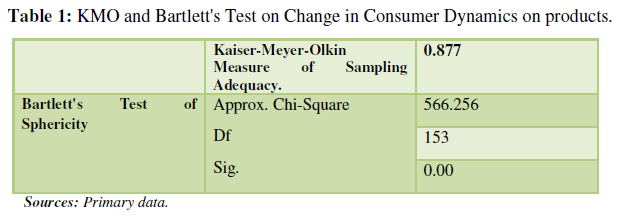

This Table 1 shows KMO and Bartlett's Test on “Change in Consumer Dynamics on products” for purchase on BoP model. The Kaiser-Meyer-Olkin Measure of Adequacy indicates that the proportion of variance in variables of perception on “Product Characteristics” that might be caused by underlying eighteen factors. Further, Bartlett's test of sphericity tests the correlation matrix, which indicates that variables are related and suitable for structure detection as the value is 0.877. So, it indicates that factor analysis may be useful with input variables of perception on “Product Characteristics” on BoP retail.
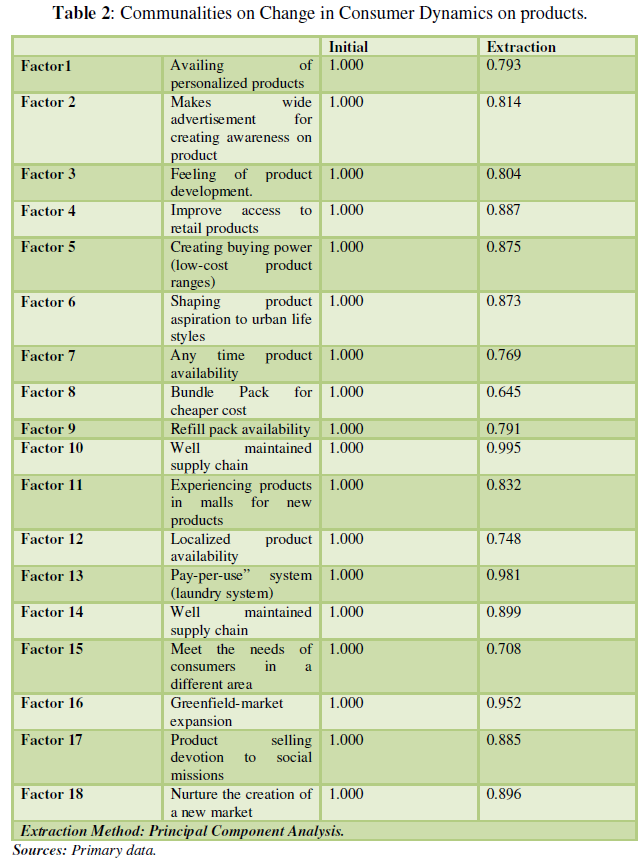

Table 2 indicates the factors responses on “Change in Consumer Dynamics on products” in BoP marketing where the initial values of all the five factor components are one and the extraction values shows more than 0.5, which means all the factors are best fit to the data and can be explored in measuring the variance to find out the most significant factor. But here all the six factor variables of “Change in Consumer Dynamics on products” are best fit for further measurement.
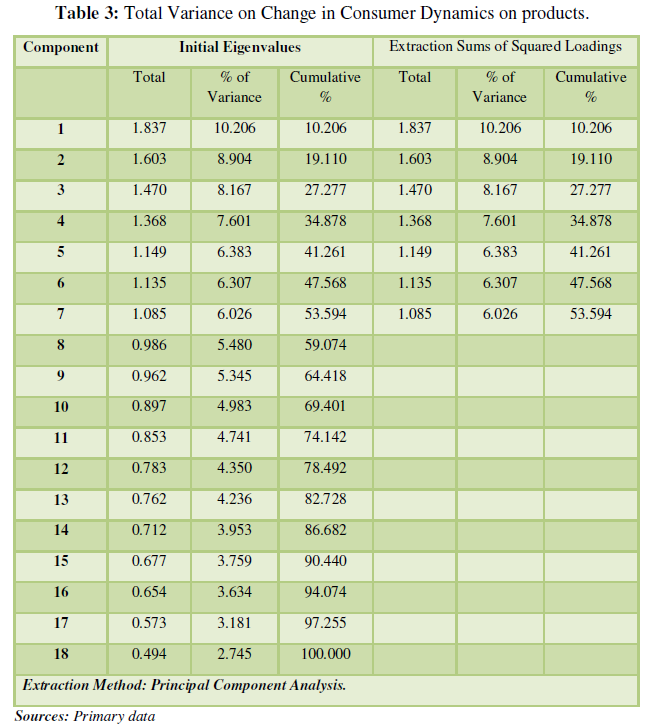
Table 3 indicates that the total variance of individual factors (eighteen) as well the extraction values of sum of squares loading values seven factors have been found in the initial Eigen values, which are positive and finite values. The process adopted here in Principal component analysis with loading values of the component scores on responses from migrated customers, which has been presented in the last column of the above table. The results are also found in extraction values for those seven factors, which are most significant among the selected factors in the initial Eigen values. So, from that it is concluded that in measuring through principal component analysis only seven factors out of eighteen factors are mostly significant with the total variance of 54 percent, which indicates a loss of 46 percent of data and needs for further analysis on Change in Consumer Dynamics on products. Further the extraction value of loading is most equal with the eigen value of the components, which also indicate of no loss of data due to the responses as presented from the responses on Likert scale.
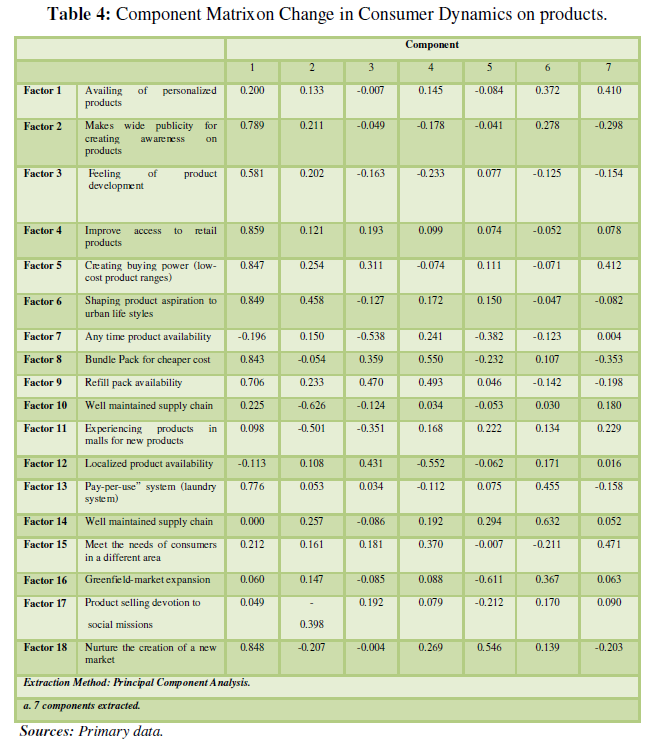

Component matrix Table 4 highlights the results of each components Variance on “Change in Consumer Dynamics on products”. The customers made their exercise on selecting the options on the eighteen variables. Out of eighteen factors, only seven factors have been extracted those have more significant positive value in the columns of components. Here the more value is marked on F2, F4, F5, F6, F13, F14 and F18 and these are the seven most significant causes for better option on “Change in Consumer Dynamics on products”. So, it is concluded that the Effectiveness of Empowerment is highlighted more significantly on F2 (Makes wide advertisement for creating awareness on product), F4 (Improve access to retail products), F5 (Creating buying power (low-cost product ranges)), F6 (Shaping product aspiration to urban life styles), F13 (Pay-per-use” system (laundry system)), F14 (Well maintained supply chain) and F18 (Nurture the creation of a new market). The other eleven factor variables are to be solved for more Change in Consumer Dynamics on products for enhancing its efficiency in BoP marketing.
Impact Assessment of Factors on Effective Empowerment
Here total 12 variables have been selected for measuring the efficiency change across gender on empowerment (Figure 1). These value score has been measured through Likert scale of 1- strongly accepted 2- accepted, 3- can’t say, 4- not accepted and 5- strongly rejected, Accordingly the measurement has been made in the following table. These variables are:
It includes following factors;
- Educating community to brings real benefits to impacted communities
- Upgrade skills and productivity to improve lives and increase purchasing power
- Identify Innovative Financing Schemes& Create Buying Power for product purchase
- Encouraging a habit of savings through BoP purchase
5. Community credit pooling with a revolving loan fund


Oneway: Gender
Here the descriptive Table 5. indicates the results of “Effective Empowerment” in BoP marketing with respect to the gender of the customers. Five statements on this factor i.e., “Effective Empowerment” have been incorporated here, which were asked to the customers of BoP marketing. The lower Mean Score
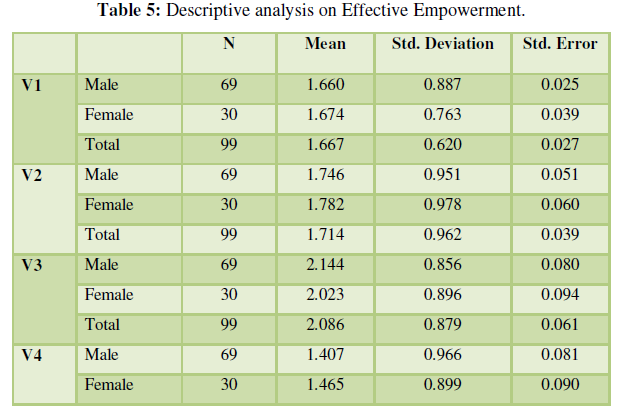



values indicate much better positive towards the attainment of more effective results on business strategy maintained by BoP retails. Here it is marked that, the male customers of factor V1 shows lower mean score i.e.,1.667, than customers of all other factors. So, it is concluded that male customers of factorV1 (Educating community to brings real benefits to impacted communities) and V4: Encouraging a habit of savings through BoP purchase (MS=1.436). have more impact for the “Effective Empowerment” practices in BoP marketing by the companies with respect to their gender.
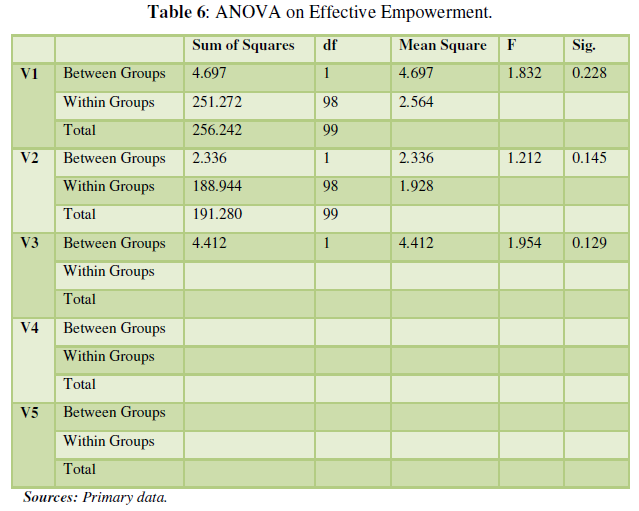

Table 6 reported the results of Anova to test the changes on “effective empowerment” by the retail malls in BoP marketing across the gender group of the customers. It shows a significant F statistic with the p-value as 0.228,0.145,0.129,0.135 and 0.124 respectively for five variables mentioned in the table. Hence, a no significant variation has been marked in all the above factors with respect to change in “empowerment” across the gender groups. That means both the groups have the same opinion on the aspect of empowerment in rural Odisha.
FINDINGS AND SUGGESTIONS
It is concluded that in measuring through principal component analysis only seven factors out of eighteen factors are mostly significant with the total variance of 54 percent, which indicates a loss of 46 percent of data and needs for further analysis on Change in Consumer Dynamics on products. It is concluded that it is more significantly on (Makes wide advertisement for creating awareness on product), (Improve access to retail products), F (Creating buying power (low-cost product ranges)), (Shaping product aspiration to urban life styles), (Pay-per-use” system (laundry system)), F (Well maintained supply chain) and F (Nurture the creation of a new market). The other eleven factor variables are to be solved for more Change in Consumer Dynamics on products for enhancing its efficiency in BoP marketing. In other cases, it is suggested to make some vision of change on the process of reengineering by the companies to make the process more efficient and to change the attitude of the rural customers in Odisha. Further there is no change is marked across the gender groups on the responses for effective empowerment in rural Odisha. So, the model should be one model for all rural groups.
- Ansari, S., & Munir, K. (2012). Impact of Bottom of Pyramid: The role of social capital in capability development & community empowerment. Journal of Management Studies Blackwell Publishing Ltd, 49(4): 813-842.
- Chandrasekhar, B.V.N.G. (2012). Consumer buying behaviour and brand loyalty in rural markets: FMCG”. IOSR Journal of Business and Management 3(2): 50-67.
- Laverde, J.F., Littlewood, A., Ellis, C., Schraner, I., & Varua, M.E. (2012). FMCG portfolio budget allocation to price promotions using modern portfolio theory. International Review of Business Research Papers 8(5): 16-30.
- Gautam, N., & Gangal, V.K. (2011). Consumers preference for FMCG products in rural India: A comparative study of HUL & ITC, APOTHEOSIS: Tirpude’s National Journal of Business Research 2(1): 115-123.
- Damodaran, H. (2002). Try Amul’s New Ice Cream and-Be Relieved. The Hindu Business Line, September 8.
- Cha, H., Cline, P., Liu, L., Meek, C., & Villagomez. M. (2003). Direct Selling and Economic Empowerment in Brazil: The Case of Avon. Edited by Anuradha Dayal-Gulati, Kellogg School of Management.
- Jain, A., & Sharma, M. (2012). Brand awareness and customer preferences for FMCG products in rural market: an empirical study on the rural market of Garhwal region. VSRD International Journal of Business & Management Research 2(8): 434-443.
- Jayswal, M., & Shah, K. (2012). A study of effect of negative emotional appeals on cognitive message processing style of Indian house wives with specific focus on FMCG products television advertisements. Asian Journal of Research in Business Economics and Management 2(3): 58-72.
- Singh, K.S. & Vinod, K., Subash C., Punia, Bijender, K., & Suresh, K.M. (2013). Modes of Advertisements Used by RuralPopulace: An Empirical Study, Researches in Business and Management-Academic and Professional Perspective, Delhi: Wisdom Publications. 404.
- Naresh, M.K. & Satyabhusan, D. (2010). Marketing Research-An Applied Orientation. 6(New Delhi: Pearson Education) 591-601.
- Mishra, U.S., Das, J.R., Mishra, B.B. & Mishra, P. (2012). Perceived benefit analysis of sales promotion: a case of consumer durables, International Research Journal of Finance and Economics 98: 145-154.
- Prajapati, S. & Thakor, M. (2012). Competitive and innovative promotional tools used by toothpaste companies for rural market and its impact on consumer buying behavior in Gujarat, International Referred Research Journal 3(2): 82-86.
- Ranu, G., & Rishu, R. (2012). Ingredient branding: A differentiation strategy for FMCG companies. Asian Journal of Management Research 2(2): 761-768.
- Hernandez. R., & Mugica, Y. (2003). What Works: Prodem FFP’s Multilingual Smart ATMs for Micro Finance.World Resources Institute. Digital Dividend Website, digital dividend.com, August.
- Rai, S. (2001). In Rural India, a Passage to Wirelessness. The New York Times, August 4.
- Singh, P., & Sharma, A. (2012). The changing face of Rural marketing in Indian economy. Arth Prabandhan. A journal of Economics & Management 1(7), October-pp.47-60
- Ashraf, S.F. (2003). Worms Found in Chocolate Packet, rediff.com, October 3.
- Sridhar, G., & Mishra, D. (2010). Executives’ social representation of rurality and product adaptation: A case of rural markets in India. APJML 23(3): 285-303.
- Srinivastava, T.N., & Sahilaja, R. (2011). Business Research Methodology. 1st ed., New Delhi: Tata McGraw Hill Education Private Limited. 14: 66-14.86.
- Sukato, N., & Elsey, B. (2009). A model of male consumer behavior in buying skin care products in Thailand, ABAC Journal 29(1): 39-52.
- Sumathi, S. & Saravanavel, P. (2003). Marketing Research & Consumer Behavior. New Delhi: Vikas Publishing House Pvt. Ltd., pp 322.
- Vaishnani, H.B. (2012). Empirical study of measuring brand equity perception with reference to sales promotion schemes for selected FMCG products. Golden Research Thoughts 1(7): 1-4.



